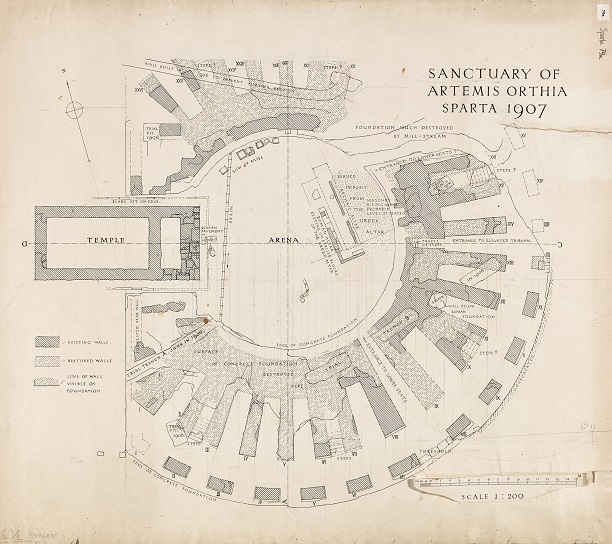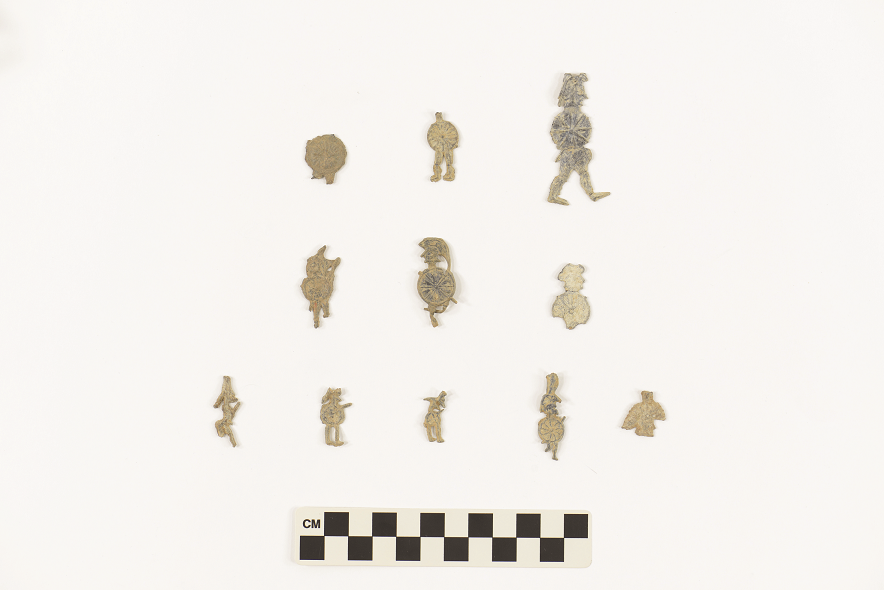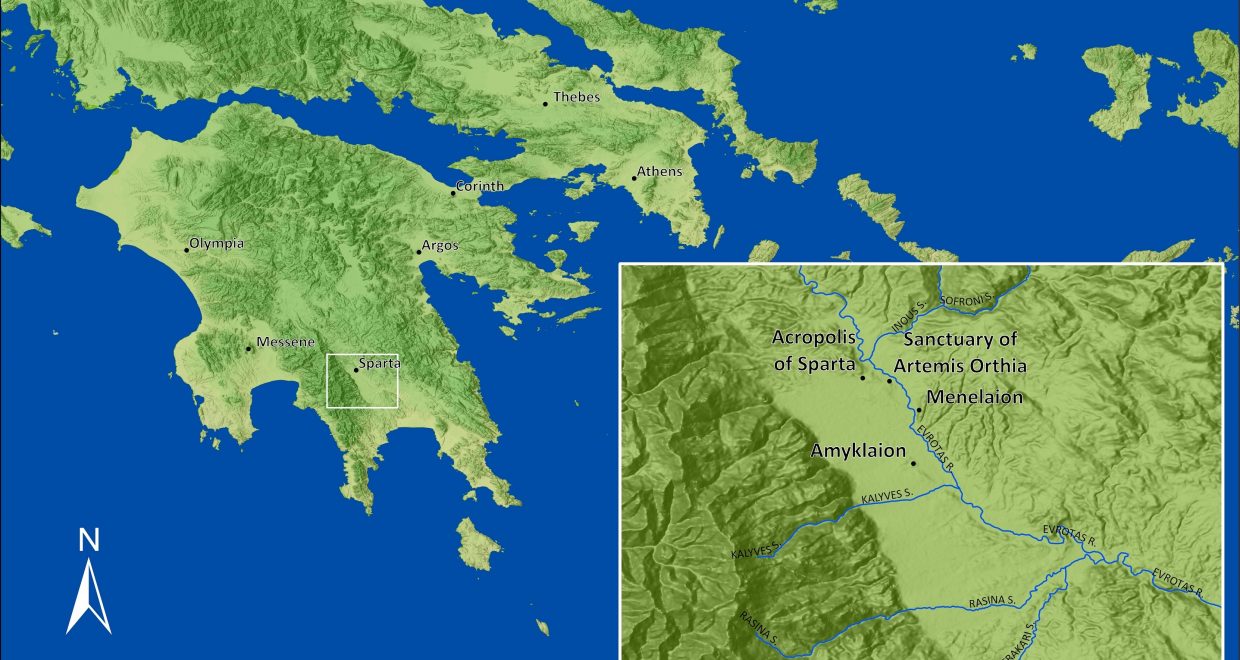Collections History and Typological Problems of Lead Figurines in the Art Gallery of Greater Victoria (Canada) from the Sanctuary of Artemis Orthia at Sparta
From 1906 through 1910, archaeologists from the British School at Athens (BSA) conducted excavations at the well-known sanctuary of Artemis Orthia in Sparta (see Dawkins 1929). Located on the western bank of the Eurotas River, the sanctuary was one of the richest and most important in Laconia during the height of Spartan power (ca. 7th–4th centuries BCE) in the Archaic and Classical Greek periods (Figs. 1, 2).

Found alongside intricately crafted bone, ivory, and bronze offerings, masses of pottery and other artefacts, perhaps the most characteristic class of material at the sanctuary of Artemis Orthia is the small but ubiquitous lead figurine (Fig. 3). More than 100,000 of these distinctive Spartan votive offerings were documented in the BSA’s excavations at the sanctuary. This assemblage is by far the greatest concentration of lead figurines yet known; the next largest concentration is at the Menelaion, where some 6,000 figurines have been documented.

As a young BSA student, Alan Wace, later BSA Director and Laurence Professor of Classical Archaeology at the University of Cambridge, was entrusted with the study and publication of the lead figurines from the sanctuary. Wace’s presentation of the material remains the definitive treatment of Laconian lead figurines today, nearly 100 years later (Wace 1929; though see Cavanagh and Laxton 1984; Boss 2000). Wace’s study was careful, systematic and detailed. But the standard documentary and analytical practices of early 20th-century archaeology—particularly the culture-historical model of cultural change that seeks to define phases of cultural development, acme and decline—leave Wace’s definitive framework in need of critical review.
Through the division of finds between the Greek government and the excavators at the conclusion of each excavation season—a common practice in Greek archaeology at the time—many lead figurines from the sanctuary of Artemis Orthia were dispersed into the personal collections of the excavators. Subsequent bequeathments and donations from these personal collections as well as direct dispensations from the Greek government facilitated the distribution of these figurines to museums and galleries across Europe and North America (Muskett 2014).
One such share of the finds must have been granted to Ramsay Traquair, a young Scottish architect based in Edinburgh. As a student at the BSA, Traquair participated in the 1906 excavation season at Sparta, in addition to conducting specialist architectural research on the medieval fortresses and churches of the Peloponnese. Nearly 60 years later, in 1965, Traquair’s niece, Mrs H. V. Bartholomew, donated a portion of Traquair’s collection, comprising 62 individual figurines, to the Art Gallery of Greater Victoria (AGGV) in British Columbia, Canada. How and when did these Spartan votives make their way to Victoria? A note written in 1910 by Traquair to his sister, Hilda Napier, provides us with an answer (Fig. 4). Sometime around 1910, Traquair evidently gifted a portion of his collection to Mrs Napier, possibly at the time of her emigration from London to Victoria in 1909. Following her death in 1965, the figurines made their way to the AGGV.

The present research affords the collection of lead figurines in the AGGV (the “Traquair Collection”) its first comprehensive study and publication. Moreover, we utilize the Traquair Collection as a means to test the applicability of Wace’s chrono-typological framework. Can the traditional typology be used to organize Laconian lead figurines in an effective manner and determine precise and accurate dates without the supporting evidence of a well-defined archaeological context with independently dateable pottery? This is an important question given the lack of well-stratified and well-published comparative material at other sites in Laconia and the inability to reconstruct the precise stratigraphy of the sanctuary of Artemis Orthia based on the descriptions and records made at the time of excavation. Wace’s typology is the essential resource for the description and dating of all subsequently recovered lead figurines in Laconian and other Peloponnesian sanctuaries.
Due to its small size, the Traquair Collection allows for the comprehensive, case-by-case analysis of a collection of Laconian lead figurines such as has not been conducted elsewhere to date. In conducting our analysis, it soon became clear that Wace’s typology required a critical re-evaluation. While not an exhaustive critique, in addition to a detailed presentation of the figurines constituting the Traquair Collection, the present article provides a necessary demonstration of the limitations of the traditional typology. Wace’s typology is, as we show, for the most part ineffective in assigning precise and accurate dates to Laconian lead figurines based on style without supporting stratigraphic and contextual evidence. Archaeological work in Laconia, including both the study of newly documented material and legacy data, will need to heed these limitations in its treatment of lead figurine assemblages going forward. In a wider perspective, this research demonstrates the valuable information that can be gained from studying small collections housed in museums and art galleries; these are sources of archaeological and historical information that are all too often neglected.
Fig. 1: Map of southern Greece and Laconia indicating position of the sanctuary of Artemis Orthia and other Spartan sanctuaries. (Courtesy of Graham C. Braun.)
The associated research – LEAD FIGURINES FROM THE SANCTUARY OF ARTEMIS ORTHIA AT SPARTA IN THE ART GALLERY OF GREATER VICTORIA (CANADA): PROBLEMS OF TYPOLOGY AND COLLECTIONS HISTORY – is free to read until the end of July 2022.
References
Boss, M. 2000. Lakonische Votivgaben aus Blei (Würzburg).
Cavanagh, W.G. and Laxton, R.R. 1984. ‘Lead figurines from the Menelaion and seriation’, BSA 79, 23–36.
Dawkins, R.M. (ed.). 1929. The Sanctuary of Artemis Orthia at Sparta: Excavated and Described by Members of the British School at Athens, 1906–1910 (Society for the Promotion of Hellenic Studies Supp. Paper 5; London).
Muskett, G. 2014. ‘Votive offerings from the sanctuary of Artemis Orthia, Sparta, in Liverpool collections’, BSA 109, 159–73.
Wace, A.J.B. 1929. ‘Lead figurines’, in R. M. Dawkins (ed.), The Sanctuary of Artemis Orthia at Sparta: Excavated and Described by Members of the British School at Athens, 1906–1910 (Society for the Promotion of Hellenic Studies Supp. Paper 5; London), 249–84.






